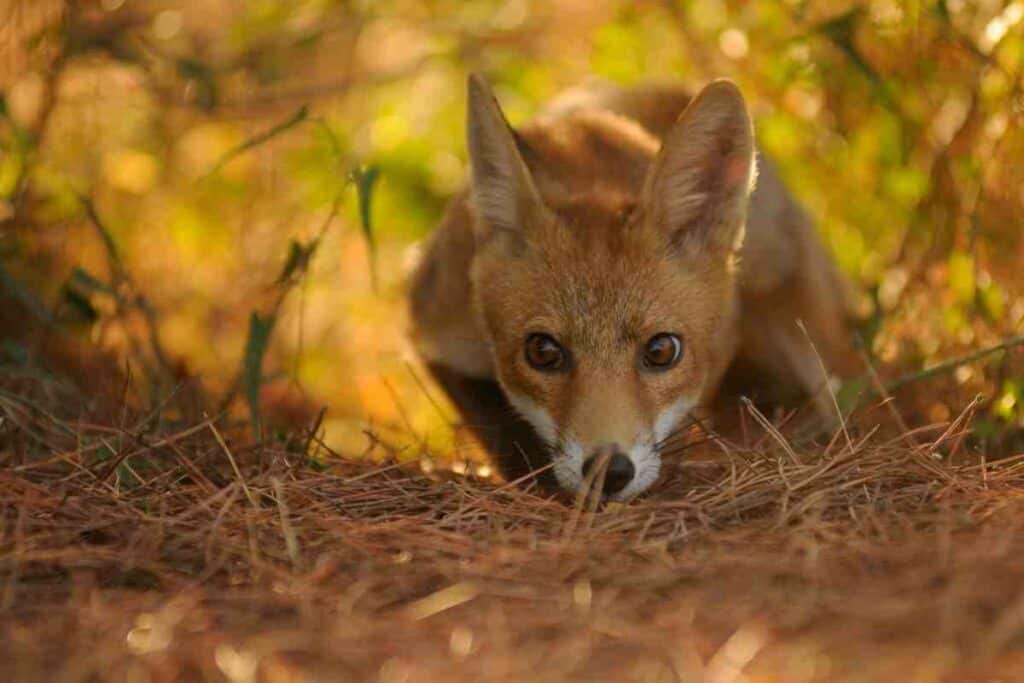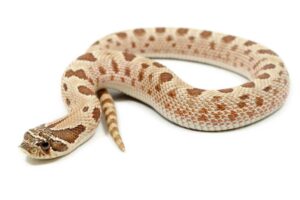Foxes are omnivorous and feed on most things they find, including fruits, seeds, and snakes.
Foxes do not necessarily love to eat snakes, but they can hunt them down or come across them as carcasses and eat them.
However, it is unlikely that foxes will attack or eat an aggressive or venomous snake. This is because snakes are not their main meal. Therefore, when hunting, foxes stick to small non-venomous snakes such as garter snakes.
Foxes are nocturnal creatures and are best known to hunt at night. It is easy for foxes to hunt snakes at night because snakes are least active when it’s cold.

Their bodies adjust to low temperatures by slowing down their conversion of food into energy. This gives foxes an advantage when hunting them.
Table of Contents
Type Of Snakes Foxes Love to Eat
Garter snakes are on the top of foxes’ dish menu for snakes. These snakes are small, non-venomous, and are not aggressive, making them easy to catch. Additionally, they are very common and inhabit the same geographical regions as foxes.
Although garter snakes bite and are fast, they are easy to target and hunt for a slinking hunting fox.
Another snake commonly eaten by foxes is the black rat snake. However, this snake is considerably bigger than a garter snake (growing up to 7 feet long), and foxes will mostly attack them when they are young.
It is important to note that foxes are opportunistic feeders. Therefore, they can eat dead snakes as well, and it does not matter the cause of their death, whether natural or not.
They can also take a leftover meal from another animal and finish it up.
How Do Foxes and Snakes Behave When They Interact?
Snakes and foxes are not the best of friends. However, in most instances, snakes are the ones that are afraid of foxes. This is despite snakes not being the primary or favorite food for foxes.
However, by nature, snakes are shy creatures and avoid contact with all other animals they do not consider to be prey.
Apart from this, foxes’ urine is a natural snake repellant. Therefore, these two animals rarely interact.
When a snake comes in contact with a fox, it will most likely run or hide.
However, if it is cornered, it can fight back. This interaction can be fatal since foxes cannot differentiate between venomous and non-venomous snakes.
That said, foxes prefer to eat mammals and other warm-blooded creatures; therefore, they only attack snakes on infrequent occasions.
How Do Foxes Hunt Snakes?
Foxes are primarily scavengers and prefer a free meal instead of hunting for one. Therefore, they are used to eating an already dead snake, but they can actively hunt them.
If they choose to hunt down a snake, they start by stalking it before attacking.
They have golden ears, which makes it easier for them to hear every sound and have pronounced tactics that allow them to kill the prey quickly.
They are likely to listen to snakes moving under the ground or sand and use the pouncing and digging method to get to their prey.
Foxes have a good sense of smell, making it easier to smell and know where the snake is. Additionally, a fox’s fur blends well with its environment, making them undetectable by most snakes.
However, despite most snakes having low vision, they have excellent motion and thermal detection. This makes it easy for them to detect both prey and predators.
How Do Snakes Protect Themselves from Foxes?
The main snake defense is camouflage. Snakes’ camouflage depends on the species and the environment they are living in. This is why there are snakes with different colors, such as black, brown, and grey.
They develop a coloration that enables them to blend with the environment, making it hard for the foxes to see them easily.
When snakes meet with a fox, they are likely to hide under rocks or bushes, wait for the fox to pass, and look for an opportunity to flee. Some snakes will burrow in the sand or even hide in already dug burrows and wait for the fox to go away.
If the snake cannot camouflage and has no other choice for hiding, the next option is fleeing. The snake will slither as fast as possible to get away from the fox.
Some snakes will move through narrow openings that the fox cannot move through, making it easier to escape from the fox.

Even though foxes are climbers, some snakes can hide between leaves, making it hard for foxes to locate them.
Snakes like garters produce foul-smelling musk whenever they sense danger or feel threatened. They use the odor to protect themselves from foxes.
However, this does not always work as foxes are known to feed on decomposing prey.
Most animals, including foxes, are not likely to attack or hunt venomous snakes. That is why several non-venomous snakes mimic the appearance of venomous snakes.
When they see a fox, some snakes copy venomous snakes’ behavior like flattening their heads to appear triangular, expanding their neck’s sides close to their head to appear bigger, or producing a hissing sound.
Some snakes will use their defensive indications to tell the fox to back down.
They can use scary sounds such as hissing; rattles snakes make noise by shaking their tail which scares the foxes away.
Rat snakes like to shake their tail in tall grass, imitating the rattling sound of the rattlesnakes because the rattlesnakes are so successful at scaring the foxes away.
Final Thoughts
Foxes do not go out of their way to hunt snakes. Nonetheless, under certain situations, they can hunt and feed on snakes.
They use skillful hunting techniques, like listening, slinking, and smell. Although foxes have great hunting tactics, snakes do not make it easy for them.
They use their defensive mechanism like hissing, mimicking, camouflaging, and spitting venom to defend themselves.










